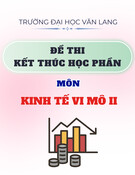
* Corresponding author
E-mail address:khakzar@jdsharif.ac.ir (M. Khakzar Bafruei)
© 2019 by the authors; licensee Growing Science, Canada
doi: 10.5267/j.uscm.2018.4.001
Uncertain Supply Chain Management 7 (2019) 109–120
Contents lists available at GrowingScience
Uncertain Supply Chain Management
homepage: www.GrowingScience.com/uscm
A multi-product inventory management model in a three-level supply chain with multiple members
at each level
Saeed Ghourchiany and Morteza Khakzar Bafrouei*
Department of Industrial Engineering, Technology Development Institute (ACECR), Tehran, Iran
C H R O N I C L E A B S T R A C T
Article history:
Received December18, 2017
Accepted April 20 2018
Available online
April 20 2018
In this paper, a mathematical model for multi-product inventory management in a three-tier
supply chain consisting of multi-supplier, a manufacturer, and several retailers is presented.
The model determines different factors such as the optimum ordering of the raw materials and
the optimal level of the production items with the optimal order of the products by retailers at
each level of the chain, with the objective of minimizing inventory management costs in the
supply chain. An algorithm is presented to determine the solution of the problem and the
implementation of the proposed method is demonstrated using some numerical example.
ensee Growin
g
Science, Canada
by
the authors; lic9© 201
Keywords:
Supply chain management
Three-level supply chain
Inventory management
1. Introduction
In recent years, an integrated assessment of the suppliers, producers, distributors and consumers that
make up the supply chain components is one of the areas that has received much attention (Pandey et
al., 2017; Rastogi et al., 2017; Shah, 2017; Tripathi & Kaur, 2017). From an operational point of view,
supply chain management integrates suppliers, builders, warehouses and storage facilities in a manner
that is effective in producing and distributing goods at the right time and in the right place, and
maintaining the total cost of the system while maintaining the appropriate level of service to the
customers (Glock, 2012). On the other hand, inventory management is one of the most important
elements in the supply chain, because a significant amount of the assets of companies lies in the amount
of their inventory, so the issues related to inventory management with the goal of minimizing the total
cost of the chain and the cost of the finished product is of great importance (Glock et al., 2014).
Today, researchers are paying a lot of attention to the development of inventory management issues for
multi-level supply chains, given that many products, such as electrical goods, food products and
pharmaceuticals, and the automotive industry, are produced at the factory, while the raw materials are
provided from different locations, so the coordination of suppliers of raw materials, manufacturers and
retailers in a supply chain plays an essential role for the success of the firms (Pal et al., 2012, 2014).

110
Below is a brief overview of some related studies conducted on inventory management models in
supply chains with more than two levels, and supply chains with more than a few members per level.
Kumar and Kumar (2016) investigated the effect of learning and salvage worth on an inventory model
for deteriorating items with inventory-dependent demand rate and partial backlogging with capability
constraints. Mashud et al. (2018) studied a non-instantaneous inventory model having various
deterioration rates with stock and price dependent demand under partially backlogged shortages.
Banerjee and Kim (1995) presented one of the first integrated models that reviewed the inventory
management of more than two members in the supply chain, in which they ordered the procurement of
raw materials in the supply chain with a buyer, a producer, and a supplier. The expansion of this model
was presented by Lee (2005), who analyzed the raw material orders in the supply chain, and, contrary
to the previous model, he assumed that the manufacturer had the possibility of ordering as much as
one-half the size of his production to the supplier and able to satisfy the own demand with several
orders during the preparation and at different intervals. Banerjee et al. (2007) extended the older work
published by Banerjee and Kim (1995), where the supply chain inquiry involves several buyers, and
each buyer receives a stock at the same time intervals by the same sender. A similar system of multi-
supplier, manufacturer, and multi-buyer was also been analyzed by Jaber and Goyal (2008), which
assumes that suppliers provide different components of the product to the manufacturer where the
manufacturer assembles those components and produces the final product. In this research, the buyer's
order cycle time is considered the same. The development of this problem can be found in the Sarker
and Diponegoro’s (2009) model, which considers only one product in the chain, and assumes that the
subsequent production cycles can be of different sizes, hence the system's flexibility has increased,
leading to reduce the total system costs.
Kim et al. (2006) proposed a modified version of the problem and examined a system that includes a
vendor that provides several different products for multiple buyers. For the ordering of raw materials
in the seller's part, it is assumed that different items are produced for each buyer with a tool. Another
related problem has been studied by Chen and Chen (2005), the authors assumed that the buyer ordered
several products for the producer, and the products were produced with the same production tool under
the same quality, although a general preparation at the beginning of the cycle production is required,
and, at the same time, minor preparations must be made to change from one product to another. In order
to save on the cost of preparing an inventory replacement program for all products, it could be helpful
to show that this program would reduce the total cost of the system. Chen and Chen (2007) and Chen
et al. (2010) expanded the model to include parameters such as price-sensitive demand and deterioration
of the products. The existence of multiple production equipment in the production sector has been
analyzed by Kim et al. (2005), and their model focused on a raw material supplier, a producer and a
buyer. The problem was determining the ordered cycles, production, and production allocations for
producers. The expanded model of this issue, which includes several products, is in Kim and Hong
(2008), where distributors who are intermediaries between the seller and the buyer are also considered
by Wee and Yang (2004), in which a delivery vendor the products are distributed to several distributors
and distributors are responsible for supplying products to each buyer. The assumption is that the periods
of product loading in the buyer area are less than the reload period in the distributor's part, and this
period in the distributor is also less than the reload period in the vendor's part. Another variant of this
model was proposed by Abdul Jabbar et al. (2007), which focuses on a supplier of raw materials, a
vendor and two buyers. Compared to Wee and Yang (2004), reload intervals in each buyer are allowed
to be larger than the reload intervals in the vendor, so more flexibility is added to the model, which
helps to maintain different costs for buyers and the seller should be considered.
Chung (2008) considered a supply chain consisting of a supplier, a producer, a retailer and a supplier
of damaged items, and a model that maximizes the overall system profit. This model was developed by
Yang et al. (2007), in which several cycles of production and re-production were added to the model.
Seliaman (2008) considered a multi-stage chain with a supplier and assumed that each member of the
chain could have multiple applicants at their lower levels. Sarker and Balan (1999) investigated a multi-

S. Ghourchiany and M. Khakzar Bafrouei / Uncertain Supply Chain Management 7 (2019)
111
level supply chain in which there is a linear function for demand and production rates, Pal et al. (2012)
considered a three layer multi-item production–inventory model for multiple suppliers and retailers.
Wang and Sarker (2006) modeled and solved a multi-level supply chain model assuming that it is not
possible to defect, Wang and Sarker (2005) examined a generalized supply chain of montage, using an
innovative algorithm based on branch and bound method to use to solve it. Roy et al. (2012) modeled
and solved the three-level supply chain with random demand and the possibility of deficiency, Pal et
al. (2014) considered a multi-level supply chain with the potential of disturbing supply of raw materials
and disturbing product modeling.
2. The proposed study
Some papers presented in the context of multi-level and multi-member supply chains were examined.
In this paper, development strategies for inventory management models for three-tier supply chains are
considered, the issue considers inventory management of a three-level chain and a few products, and
the main components of this chain include the supplier sector, a manufacturer and retailer, in which the
supply chain of each supplier is responsible for supplying one of the components or raw materials, and
after sending the parts to the part production, the percentage composition of the components and raw
materials are turned into finished products and sent to retailers. In this model, in addition to determining
the optimal amount of raw material order, the optimal amount of the production and optimal order of
retailers are also determined. In this paper, an initial mathematical model of inventory management is
presented. In order to determine the optimal problem solution, an innovative algorithm is used. At the
end, numerical examples of the problem are implemented, the schematic representation of this problem
is shown in Fig. 1.
Fig. 1. The structure of the proposed study
2.1. Assumptions
As stated, the proposed study considers an inventory management of a three-tiered and multi-product
chain, and the main components of this chain are multi-supplier, manufacturer, and multi-retailer, and
the following assumptions are considered for this issue.
The problem is considered as a multi-product and integrated management of inventory of
products at different levels of the chain, simultaneously.
It is assumed that each supplier is solely responsible for supplying one component or raw
material.

112
In this case, n parts are received from the suppliers and in the production sector, they are
converted into m final products, and the products are sent to k retailers, eventually each
product is delivered to a specific customer.
The amount of demand in each level is considered known.
Delivery times between suppliers, manufacturers and retailers are negligible.
There is no shortage.
Details of the target functions, constraints and problem variables at each level of the chain are as
follows,
The objective function of the problem is to minimize the cost for the entire chain in an integrated
manner.
The decision variables include the optimal order quantity of each product in the retailer, the
optimal production rate of each product in the manufacturer's part, and the optimal order
quantity of each of the primary components in the supplier's part.
Retail costs are the cost of purchasing from the manufacturer, the cost of ordering, and the cost
of maintaining the products.
The costs of the manufacturer's part are the cost of purchasing the product, the cost of preparing
the product and the cost of maintaining the products.
The costs of the supplier's part include the purchase price, the ordering cost and the cost of
maintaining the raw materials.
Maintenance, preparation and ordering costs are different at each level of the chain and the
horizons are considered indefinitely.
Variables
hsi The cost of holding the raw materials for the supplier i
Csi The cost of purchasing raw material from the supplier i
Tsi Time period for consuming raw materials from the supplier i
Dsi Request for the original supplier of the i
Qsi The order quantity of supplier i
αij Percentage of raw material used from supplier i to produce product j
Ii The average of raw materials of the supplier i
ACSi Average cost of inventory per unit time for the supplier's i
ACS Average inventory costs per unit time for all suppliers
Pj Production rate of product j
hmj The holding cost of the j-th product for the manufacturer's side
Ij Average inventory of product j
Tmj Period of production and consumption of product j in the manufacturer’s side
tmj Period of production of the product j in the manufacturer's part
CPj Production cost per unit of product j
Dmj Demand for product j
pj The production rate of product j in the manufacturer’s side
Qmj The amount of production of the product j in the manufacturer's part
ACMj Average costs of inventory of jth product per unit time in the manufacturer
ACM Average cost of inventory per unit time in the manufacturer's part
Dcjk The final customer demand of the k-th retailer for the jth product
hrkj The holding cost of the product j for the k-th retailer
Trkj The period of the j product for the k-th retailer
Drkj The demand for product j in the retail chain
Qrkj order quantity in retailer side

S. Ghourchiany and M. Khakzar Bafrouei / Uncertain Supply Chain Management 7 (2019)
113
ACRk The average cost of inventory per unit time in the retail chain k
ACR Average inventory costs per unit time for all retailers
ACT Average inventory costs per unit time for the entire chain
Kr Frequency of orders for delivery of raw materials in the supplier's side
mj The frequency of sending the j-th product to retailers in a production cycle
fj The frequency of sending the j-th product to retailers when they produce a production cycle
ni The frequency of sending the i-th raw material in each supplier's order cycle
Z Dimensional matrix of variables in the Hsian matrix of the target function
λ Eigenvalue
The level of inventory in the supplier's part number i at any time is as shown in Fig. 2.
Fig. 2. Material inventory chart in the supplier's part
The inventory costs in the supplier's side include the purchase, order, and inventory costs, as determined
below.
The cost of purchasing the raw material by the supplier i
CQ (1)
The cost of ordering the raw material by the supplier i
(2)
The relationship between the amount of the raw material supplier and the amount of production:
The quantity of the initial material i for each period ni is equal to the total amount of the primary
material used in the manufacturer's production side, which is included in the following formula in the
model,
=∑
Average inventory of raw material by the supplier i in each period is as follows,
12⋯1
1
2
1 1
21
(3)
Costs of inventory of raw material by the supplier i in each period are as follows,
1
2h1
(4)
Total inventory costs per supplier period
CQ+
+
h1∑ (5)














![Bài tập Kinh tế vi mô kèm đáp án [chuẩn nhất]](https://cdn.tailieu.vn/images/document/thumbnail/2025/20250923/thaovu2k5/135x160/19561758679224.jpg)











